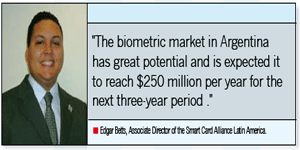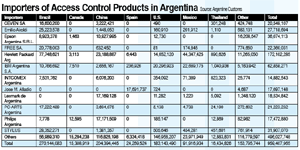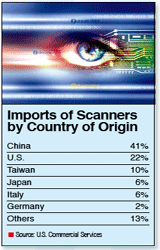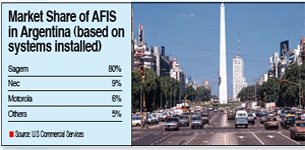Following a disastrous economic crash in 2001, the Argentine electronic security market is making a strong recovery. Growth in the past five years has seen this South American nation reassume its position as one of the market leaders, particularly in the adoption of advanced technology.
Following a disastrous economic crash in 2001, the Argentine electronic security market is making a strong recovery. Growth in the past five years has seen this South American nation reassume its position as one of the market leaders, particularly in the adoption of advanced technology.

Argentina is one of the top three markets in Latin America for access control and smart cards," explained Edgar Betts, Associate Director of the Smart Card Alliance Latin America. "The top two are Brazil and Mexico in that order. It is also a top 3 market for digital signatures." He further noted that Mifare cards are being used in not only transportation applications but also access control so the numbers are "a bit mixed up."
Previously, Argentina was "a very interesting market for access control," said Betts. This was before the economic crash in 2001. "It was the first to introduce many advanced solutions; many organizations in the country were migrating to high-tech systems." Looking at the percentage points before the crash, he added, the numbers were "similar or higher than in Brazil and Mexico, which are traditionally considered Latin America's most advanced markets for access control." The crash strongly affected this, but the major economic recovery over the past four to five years has seen Argentina "begin to return to leadership in the Latin American market." Activity there, said Betts, is "now similar to Brazil."
Others were less rosy about the state of development. "Access control in Argentina is being done in mainly two ways: human surveillance and RFID cards for use in the private sector," shared Alejandra Etcharran, Automation and Electronics Industry Analyst, Latin America for Frost & Sullivan. "Every time someone enters a bank or private company, they show their ID and then they are given a shortwave, contactless RFID card." Argentines, in her view, however, are not using smart cards that much. She finds that there is "only some adoption of smart cards for access control, mainly by multinational companies such as Siemens or for certain key events."
According to Etcharran, this stems from a lack of knowledge of smart cards. "Few people understand how these can add value to the same solutions or be integrated with other solutions to provide greater bang for the buck. Again, we are talking about long-term benefits like higher quality and higher capacity, but this does come at a higher initial cost." Brazil, in contrast, is already looking at biometrics and smart cards to a far greater degree, she concluded.
HID is definitely the biggest player by far in Argentina in terms of access control, pointed out Betts. Etcharran agreed. "The players vary according to whether you are looking at physical or logical access control. Before the crash, Gemplusnow renamed Gemlatowas very active. Then, there are regional companies offering smart-card solutions and local representatives working for international companies, but they are in no way as important as the big companies with offices there."
Jason Bohrer, General Manager Americas for HID Global, chimed in, explaining that, "Argentina continues to show steady growth for our business and makes up a considerable amount of our total Latin American market share. There is strong interest in 13.56-MHz technologies, biometrics and multi-application offerings."
What Argentina Is Buying
According to Argentine Customs figures, in 2004, US$83.89 million's worth of digital processors were imported: $164.29 million in input and output controls, $66.55 million in other automatic devices used for data, LAN devices and control units and/or adapters, $29.81 million in controllers, and $21.52 million in cards and EAS tags, controllers and readers. The following year, these figures were $96.30 million for digital processors, $236.85 million for input and output controls, $88.74 million for other automatic devices used for data, LAN devices, control units and/or adapters, $44.99 million for controllers, and $31.35 million for cards and EAS tags, controllers and readers. Again, industry experts caution, as did Betts, that these numbers are a bit murky; a lot that is being imported in this area may not have direct implications for the electronic security sector.
Marina Millet, Commercial Officer, U.S. Commercial Services, citing Argentine Customs in a report, provided the following breakdown on importers of access control product by importer and by country. (See diagram below; all figures are in U.S. dollars.)
Where the Market is Heading 
"The key to this market," said Betts, "is interoperability between physical and logical access control." The major push is coming from the government, which has a very strong stake in the sector. "It is setting up the infrastructure for what is coming next. Without this infrastructure, there are no possibilities for further development as it is the government that has to be the one to set the standards and develop the basic infrastructure. When that is in place, private organizations will be able to broaden access control systems to include other applications such as online banking, tax payment, and public transportation. A common parameter is needed in order for all of these applications to work together." This is not only true within the country but also for use in the international arena of Mercosur, were interoperability agreements between Brazil, Venezuela, and Argentina have taken place regarding digital identities, he concluded.
With upcoming implementation of a new national database, the Argentine Ministry of Interior promulgated the National Standards for the Acquisition and Implementation of Biometric Systems for the Purpose of Identity Identification and Verification. This set of standards is based on the most common worldwide standards used in biometric technologies for easy interoperability with any international system that requires biometric data exchange.
Besides interoperability, Betts explained, the national organization of technology and information is working on smart cards with digital signatures. "There has, however, to date, been no official system launch; this is still in the pilot phase. There needs to be coordination with her national governments, particularly those in Mercosur before this can proceed. Again, interoperability is the crucial requirement."

Bright Future for Biometrics
Another key growth area, said Betts, is biometrics. "In fact, in November of 2006 was the first biometric conference in Argentina. Biometrics is being used mostly to increase security inside the government. Other applications which include citizen biometrics are the national ID, driver License and electronic passports. Other markets are worker identification for physical and logical access control for private companies." When it comes to putting biometrics on cards, the government is definitely the one doing most of the moving. "The Argentine government," commented Betts, "believes that adding biometric information on the smart card helps add features to the biometrics in a secure form. Keeping the biometrics in a central database instead of the card can cause security problems if compromised, while on the card you can reduce the risk factor while improving security. This process is still under way."
The biometric sector has strong potential for growth over the next few years because of increased security measures and new identification systems. The government has initiated projects that require biometric technology for identification of individuals both at border crossing points and within the country. According to Silvia Yaber, Commercial Officer at the U.S. Commercial Services, industry sources predict 150 percent to 200 percent growth in the biometric market in Argentina over in 2007 and 2008, albeit with the proviso that projects currently under way go forward as scheduled. "The biometric market in Argentina has great potential," said Millet, "and is expected it to reach $250 million per year for the next three-year period."
At present, the Camara Argentina de Seguridad Electronica (CASEL) estimates that there are more than 3,000 biometric systems installed in Argentina in both the government and corporate sectors. "There are around 150 companies that sell biometric products and systems in Argentina," said Yaber. "Most are distributors or resellers of many of the 40,000 brands of biometric products from around the world.
"We have set up a distribution center in Buenos Aires," said Bohrer, "to show our commitment to the market and to better cater to local requirements with timely products." According to Bohrer, there are fewer customs regulations in Argentina than in the region, particularly when compared with Brazil, but manufacturing locally enables HID to cater to local integrators while also servicing large multinational partners.
According to one industry player, "Argentina is very similar to Brazil in that each region has its own local integrators, and there is very little channel differentiation." Most of these players, he said, end up cooperating on large projects. Then, there is a long list of integrators that fall below the major players with a lot of support from other local players.
Of the brands being sold in Argentina, clarified Yaber, almost 70 percent are from the U.S. The remaining systems and products come from China, Germany, Japan, Taiwan, France, Canada and Italy."
There are definitely opportunities for Asian players, observed Betts, as the market is growing strongly. That said, there are very few Chinese, Taiwanese and Korean companies active in the smart-card or access control markets there. "I have seen a few more companies from Asia participating in conferences in the region over the past year so that would indicate to me that there is definite interest among Asian companies in the Argentine market. We have seen an increase of Korean companies offering biometric solutions in the region. There are some who feel that in order to provide competitive prices quality of products have not been able to comply with some of the stringent quality standards. (See table below for a breakdown of scanner imports by countrynote the strong presence of Asian nations.)

Technology and Product Breakdown
"While most people think of fingerprint recognition," said Betts, "a lot more facial recognition is being used for verification of individuals. This involves comparing face from security cameras with driver license picture database records. Eventually, the Argentine government will incorporate this for use in driver licenses, passports and government IDs. The Argentine government has been very good at adding biometrics. In fact, these digital documents are all ready."
In the AFIS segment, Yaber pointed to Sagem as the clear market leader with other major providers like Motorola, NEC and Identix. While NEC and Sagem have also sold biometric access control systems through fingerprint scanning, card readers or proximity readers, only U.S. companies (Crossmatch and Identix) have 10-fingertip readers on the market (Lifescan). Meanwhile, three-dimensional hand readers are offered mainly by two U.S. suppliers, Recognition Systems Inc. and Microsoft, the former having the larger market share.
According to Yaber, there are many brands of small one-fingertip scanners for computer access on the marketeven some OEM vendors from China and other Southeast Asian countries that customize to importer requirements. That said, the main brand is still Digital Persona (U.S.). "This brand," said Yaber, "has the largest market share in this segment and is considered to be of high quality. The best selling model at the moment is URU4000." Other brands include Precise Biometrics, ActiveCard and Bioscrypt.

In addition, Yaber explained that readers and scanners from China and Taiwan are generally packaged solutions with limited features and no local support, while those from the U.S. have much more flexibility, allow generation of software in Spanish and customization of systems. Finally, she pointed also to local products, such as system integration offered by Argentine companies like Biometrix Group and Bio Card S.A.
Based on the U.S. Commercial Services report, under HS Code 8471.90.14, scanners are assessed a 2 percent import duty and a reduced VAT of 10.5 percent rather than the normal 21 percent. The other HS Code class for these products is HS 8471.90.19, upon which an import duty of 11 percent is assessed and a VAT of 10.5 percent. Furthermore, Yaber noted that Resolution 92/98 requires that all electric products (those products that are plugged into power outlets) imported into Argentina comply with basic electric security standards.